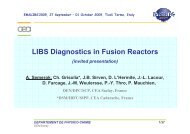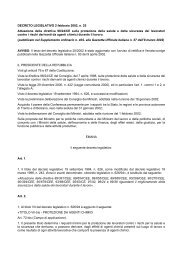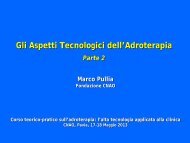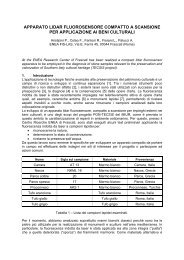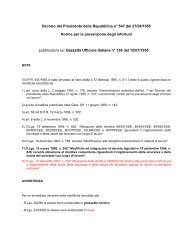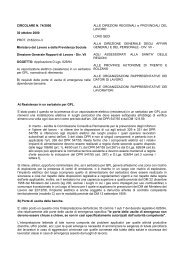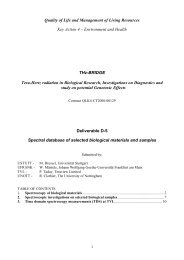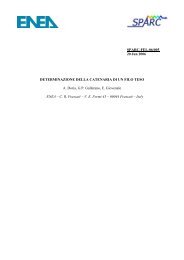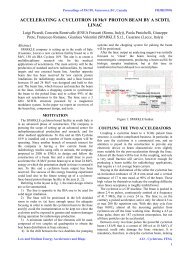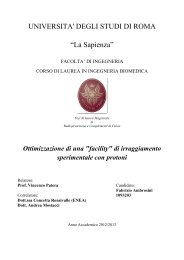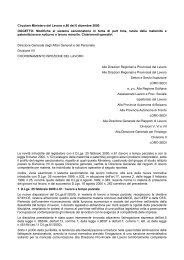Theory, Design and Tests on a Prototype Module of a Compact ...
Theory, Design and Tests on a Prototype Module of a Compact ...
Theory, Design and Tests on a Prototype Module of a Compact ...
You also want an ePaper? Increase the reach of your titles
YUMPU automatically turns print PDFs into web optimized ePapers that Google loves.
1. GLOBAL PARAMETERS OF THE ACCELERATOR 25<br />
structure; then we c<strong>on</strong>tinue with the analysis <strong>of</strong> a cavities chain, coming<br />
to the properties <strong>of</strong> the single cavities <str<strong>on</strong>g>and</str<strong>on</strong>g> the last secti<strong>on</strong>s are devoted<br />
to their design. Particular emphasis is <strong>on</strong> the design <strong>of</strong> the coupling<br />
mechanism for the feeding <strong>of</strong> the structure through a waveguide in the<br />
last secti<strong>on</strong>. It is apparent that the various steps have a reciprocal<br />
feedback <str<strong>on</strong>g>and</str<strong>on</strong>g> are not completely close each other, but in any case they<br />
give a way to follow.<br />
Finally, it is worth noting that we lead with a procedure that was<br />
not completely followed during the design <strong>of</strong> first LIBO module, because<br />
<strong>of</strong> problem <strong>of</strong> time <str<strong>on</strong>g>and</str<strong>on</strong>g> <strong>of</strong> feasibility <strong>of</strong> proposed soluti<strong>on</strong>s. This<br />
is normal because we remember that the first LIBO module was a<br />
pro<strong>of</strong> <strong>of</strong> principle <str<strong>on</strong>g>and</str<strong>on</strong>g> then it was thought golden plated. In this sense,<br />
we hope that the procedure presented will be a first attempt to have<br />
a methodology easy to transfer to an industrial c<strong>on</strong>structi<strong>on</strong> <strong>of</strong> these<br />
type <strong>of</strong> structure instead.<br />
1. Global Parameters <strong>of</strong> the Accelerator<br />
An accelerator for hadr<strong>on</strong>therapy needs low producti<strong>on</strong> costs <str<strong>on</strong>g>and</str<strong>on</strong>g><br />
not large overall dimensi<strong>on</strong>s <strong>of</strong> the structure. Both points are necessary<br />
for a feasible installati<strong>on</strong> in medical centers <str<strong>on</strong>g>and</str<strong>on</strong>g> hospitals. The sec<strong>on</strong>d<br />
point can be satisfied if the cavity are small in dimensi<strong>on</strong>s <str<strong>on</strong>g>and</str<strong>on</strong>g> stacked<br />
as much as possible. Furthermore, if these cavities let easily flow the<br />
power, it is possible to use a single alimentati<strong>on</strong> for a large amount<br />
<strong>of</strong> cavities. In reality, the type, the entry energy, <str<strong>on</strong>g>and</str<strong>on</strong>g> the velocity <strong>of</strong><br />
particles suggest the type <strong>of</strong> the structure with a good efficiency to use.<br />
In our case, prot<strong>on</strong>s <str<strong>on</strong>g>and</str<strong>on</strong>g> 60 MeV beam entry energy suggest exactly a<br />
multi-cell coupled structure.<br />
The choice <strong>of</strong> the frequency <str<strong>on</strong>g>and</str<strong>on</strong>g> <strong>of</strong> the total length <strong>of</strong> a normalc<strong>on</strong>ducting<br />
structure comes applying the Kilpatrick criteri<strong>on</strong> [16, 26,<br />
27] which states the maximum value for the electric field in each cavity<br />
before breakdowns <str<strong>on</strong>g>and</str<strong>on</strong>g> sparking occur. The Kilpatrick results were<br />
expressed in a c<strong>on</strong>venient formula given as<br />
f = 1.64E 2 Ke −8.5/EK , (3.1)<br />
where f is the frequency in MHz <str<strong>on</strong>g>and</str<strong>on</strong>g> EK is in MV/m <str<strong>on</strong>g>and</str<strong>on</strong>g> it is said the<br />
Kilpatrick limit. The behaviour <strong>of</strong> formula (3.1) is shown in figure 3.3.<br />
The Kilpatrick criteri<strong>on</strong> is based <strong>on</strong> experimental results, <str<strong>on</strong>g>and</str<strong>on</strong>g> nowadays<br />
it is c<strong>on</strong>sidered c<strong>on</strong>servative; the formula is still used, except that the<br />
actual peak surface field is expressed as ES = bEK, where b is known<br />
as the bravery factor <str<strong>on</strong>g>and</str<strong>on</strong>g> it is chosen in a range from 1.0 to 2.0.<br />
Let us enter now in the details <strong>of</strong> the first LIBO module; the large<br />
availability <strong>of</strong> low cost power klystr<strong>on</strong>s at 3 GHz could be a good reas<strong>on</strong><br />
to choose that frequency. The corresp<strong>on</strong>dent Kilpatrick limit is around<br />
47 MV/m. After that, <strong>on</strong>e has to c<strong>on</strong>sider:





